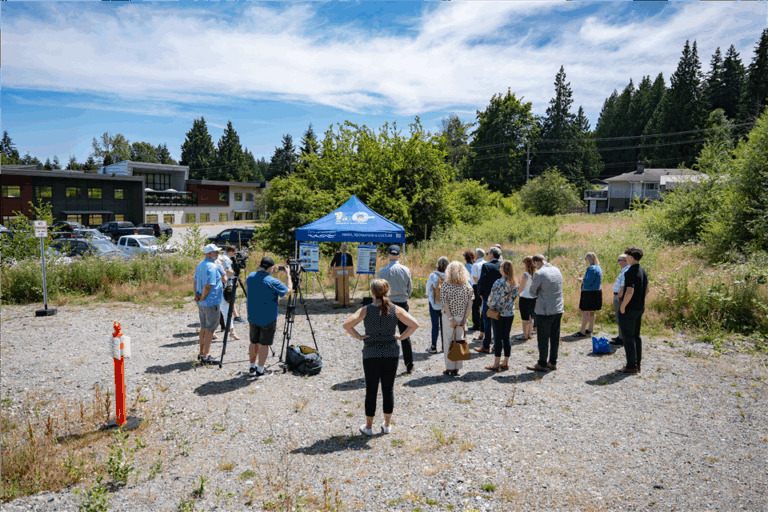Yukon Energy has announced that a site on Robert Service Way near the Alaska Highway will be the future home of its grid-scale energy storage project in Whitehorse. Once complete, the 7 megawatt / 40 megawatt-hour battery will be the largest grid-connected battery in the North, and one of the largest in Canada.
The final battery site is located on the overlapping Traditional Territories of the Kwanlin Dün First Nation and Ta’an Kwäch’än Council. The site is located on Kwanlin Dün First Nation Settlement Land and on land identified by the First Nation for future development.
Yukon Energy made the decision to proceed with the site near the Alaska Highway after completing a fulsome assessment that looked at each site’s technical, economic, and socio-economic attributes.
“Yukon Energy is firmly committed to establishing mutually-beneficial and strategic partnerships with First Nations governments and development corporations to build Yukon’s clean energy future,” said Andrew Hall, president and CEO of Yukon Energy. “I would like to extend my sincerest thanks to Kwanlin Dün First Nation, Ta’an Kwäch’än Council, and to each of their representatives, for collaborating with us on the battery project. I personally look forward to continuing to working with both First Nations and their representatives in the coming years as more opportunities for green energy in Yukon come to fruition.”

A Battery Project Steering Committee with representatives from Yukon Energy, Kwanlin Dün First Nation and Ta’an Kwäch’än Council was formed in August 2020. Since then, the three parties have been working together to assess location options for the battery and opportunities to maximize First Nations benefits from the project.
Yukon Energy, Ta’an Kwäch’än Council, and Kwanlin Dün First Nation’s development corporation, Chu Niìkwän Development Corporation, have also signed a Term Sheet outlining Yukon Energy’s commitment to provide investment, procurement, contracting, and partnership opportunities to both First Nations as part of the project.
“Our Development Corporation, Chu Niìkwän’s investment in this project will lead to increased opportunities for Kwanlin Dün First Nation citizens and improve access to clean stable electricity for all Yukoners,” said Chief Doris Bill, Kwanlin Dün First Nation. “By participating in projects like this on our Traditional Territory we are realizing and activating our potential for economic development that was laid out in Chapter 22 of our Final Agreement. We wish Yukon Energy success in managing and delivering this innovative project. We see it as another step toward stabilizing Yukon’s isolated grid and reducing Yukon’s reliance on fossil fuels for back-up power generation.”
The agreement provides provisions for Yukon Energy to enter into trilateral negotiations with Kwanlin Dün First Nation and Ta’an Kwäch’än Council to develop Project Benefit Agreements with each First Nation with the overall objective of Kwanlin Dün First Nation and Ta’an Kwäch’än Council to share available benefits to the extent possible. Each First Nation’s Project Benefit Agreement will be subject to approval by the appropriate First Nation’s government, and other government and regulatory bodies.
“Ta’an Kwäch’än Council is in full support of this project, as it will help to reduce diesel consumption and reduce Yukon’s carbon emissions. TKC looks forward to the opportunity to participate on this initiative as we are a committed partner alongside Kwanlin Dün First Nation,” said Chief Kristina Kane, Ta’an Kwäch’än Council.
The new battery is a critical investment in Yukon Energy’s ability to meet growing demands for electricity and to respond to emergency situations. As an isolated grid, one of the largest challenges Yukon Energy faces is meeting peak demands for power during winter months.
The battery will store excess electricity generated during off-peak periods and provide Yukoners with access to more power during peak periods, reducing the amount of diesel needed at that time. Over the 20-year life of the project, the new battery is expected to reduce carbon emissions in Yukon by more than 20,000 tonnes.
The Government of Canada has previously announced $16.5 million in funding for the battery through the Green Infrastructure Stream (GIS) of the Investing in Canada infrastructure plan. Yukon Energy’s investment in the battery is expected to be approximately $14.5 million.
Three different sites were originally proposed by the Steering Committee as potential locations for the battery – two in Whitehorse near Yukon Energy’s operations on Robert Service Way and one on the North Klondike Highway. All three potential sites were on First Nations Settlement Land and located on the overlapping Traditional Territories of the Kwanlin Dün First Nation and Ta’an Kwäch’än Council. In December 2020, Yukon Energy announced that the site on the North Klondike Highway was eliminated from consideration after the Corporation received strong public opposition to the site.
The battery is scheduled to be installed and in service by the end of 2022.











